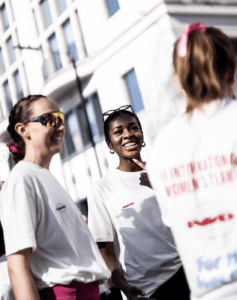Fast fashion and sustainability – seemingly incompatible terms with no apparent happy medium, with the former being to blame for hindering the latter.
By now, we should all be well aware that there is a price to pay for super affordable clothing. It’s a relatively small cost to us – a much bigger cost to the environment and third world garment workers. So, what can we do to change this and tackle our fast fashion habits?
Introducing the Greenfluencers – eco warrior forces for good, encouraging us to spend less and save more (money and the planet that is).
Sustainability credibility is majorly shaping the way we look at the fashion and beauty industries, and while there have been big influencers from Venetia Falconer and Camilla Thurlow who have long been pushing this message, it’s the micro influencers targeting their friends and family to make little changes with big impact who often go unnoticed for their vigilante work.
For this weeks’ Trendsetters, I spoke to charity worker and sustainability enthusiast, Hannah Jordan of @basicbrecyles, who had some thought provoking insights and advice to share:

Why is it so important to you to encourage others to live sustainably?
“I had no idea about living sustainably and the negative impact I was making – especially with fashion. I just assumed there were rules that retailers had to follow and never thought I was part of the problem. Upon a quick google search, I was shocked to learn about greenwashing and the other lies we are fed to keep us in the dark. I just want more people to be aware of the problem, especially with the fast fashion content we’re bombarded with on a daily basis on social media.”
What are the warning signs when shopping from a brand we’re not familiar with?
“If they constantly have new products in, thousands and thousands of products in the ‘new in’ section and anything suspiciously low priced. Take a £5 top for example, if it’s been made consciously with the environment and the workers human rights in mind then it just couldn’t be that cheap. Companies that keep up with all of the seasonal trends, companies that constantly have sales with crazy reductions and discount codes. Also the materials, if it’s not 100% cotton or organic cotton then that’s usually a sign that it’s not been made with sustainability in mind and the people making it most likely haven’t been paid or treated fairly. Also if a brand actually cares about the environment they won’t be sending loads of influencers mountains and mountains of ‘gifted’ clothing for free – this is irresponsible, the shipping, packaging and so on.
“Keep an eye out for recycled collections too – it’s often not the total honest truth and just a marketing ploy. It’s important to do your research.”
What are some of the easy changes you encourage your friends and family to make?
“Instead of buying new things, check to see if you already have something that could work or something similar. Borrow from your friends and family or swap items too. Always think of the ‘30 wears test’ especially if you have to buy fast fashion – before you buy think ‘will I wear this 30 times?’. But mainly if you can, shop second hand, on Depop, Vinted, eBay or in stores, but still apply the ‘30 wears test’.”
Prior to Macklemore’s 2012 hit Thrift Shop, the idea of shopping second hand brought to mind rummaging through racks of tatty and outdated clothing. Today, with over 21 million users (90% of whom are estimated to be under the age of 26), Depop has helped to make shopping secondhand cool and fast fashion ‘basic’.
Over on TikTok, Gen Z have found clever ways to upcycle their thrifted products with the #ThriftChallenge. They might turn a hoodie into a handbag or Dad’s old shirt into a two piece co-ord.
But fashion is just the tip of the iceberg. There is so much more we can do with the guidance of the Greenfluencers to reduce our negative impact on the world’s health. Be it second hand shopping, reducing plastic waste, veganism, upcycling or simply just walking a little more – there’s plenty of ways for us to spend less and save more.
Here are some of my favourite Greenfluencers, using their influence to be a force for positive change:






